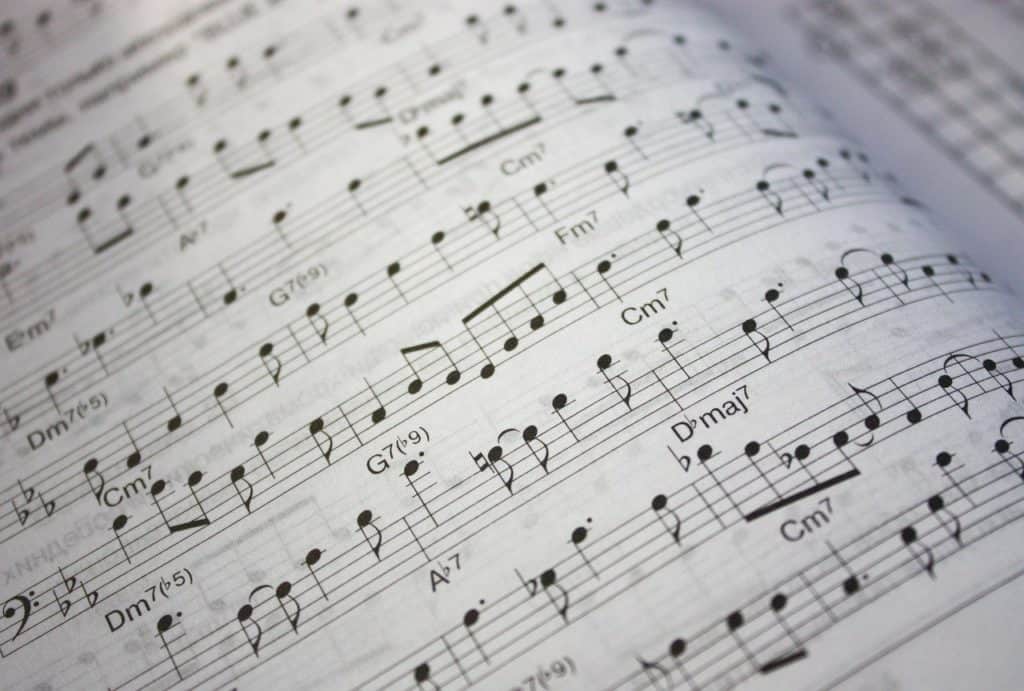
Music theory is a very important part of music production.
Learning music theory can seem very difficult for a beginner with no theory knowledge at all. This is why its essential to learn the following fundamentals in the following order: Notes and Pitches, Scales and Modes, Key, Intervals, Chords and Diatonic Harmony.
Music theory is an extensive subject that will require practice and an eagerness to learn on your part.
Therefore learning it through a course or a book will be very helpful.
Having a keyboard to practice on will also be highly helpful in making sure you apply what you learn.
Let’s briefly look into each of these
Notes and Pitches
A note is the name that is given to a specific pitch that is associated with a specific audio vibration.
The most musical notes are C C# / Db, D, D# / Eb, E, F, F# / Gb, G, G# / Ab, A, A# / Bb, B
These notes are spread out over what are called Octaves, all the notes appear in the same order on all octaves.
An octave is simply an interval whose higher note has a vibrational frequency that is twice of its lower note.
Pitch is how the human eye understands and interprets the frequency of sound.
For example when you press any key on the piano, it produces a sound wave. The sound wave is simply air vibration molecules that go back and forth creating pressure which then comes from the instrument and is picked up by our ears.
The simplest and alternative definition of pitch is simply the frequency of a note.
Therefore, the higher the pitch, the higher the frequency and the lower the pitch, the lower the frequency.
Pitch is measure in Hertz denoted as HZ and you’ll run into this on your frequency and spectrum analysers and EQ tools.
Scales and Modes
Musical scales are represented by staves because the word scale comes from a Latin word which means ladder, therefore you can think of scale as the Climbing of a ladder.
By definition a scale is a group of notes that are basically arranged in either an ascending or descending order of pitch.
In an ascending scale each note is higher in pitch than the last note, and in a descending scale each note is lower in pitch than the last note.
There are basically 48 musical scales that are used in composition and these scales are made up of Major and Minor forms.
Let’s get into Modes.
There are 7 types of modes in music theory and I’ll start by explaining exactly what a mode is.
In music theory, Modes are simply a type of scale that has distinct characteristics.
The 7 modes are Ionian, Dorian, Phrygian, Lydian, Mixolydian, Aeolian and Locrian. Each mode has a specific musical color that is unique.
Modes are pretty easy to learn and once you get the basic idea you’ll be able to use them in your own music with ease.
Key
A Key in music, simply put; is a group of notes and pitches that all stem from either major or minor scales.
In a song, the main pitches used are usually from one particular scale and the name of the key comes form this scale.
This means that if a song is created in the A Minor scale, it means it has no sharps and flats in it and this may indicate that it is in the A Minor Key.
Understanding Key is a vital part of music theory and should one of the very first things that a person learns in order to start understanding the correlation of different elements of music theory.
Intervals
Intervals in music theory are the difference in the pitch between two sounds. They are a fundamental part of musical structure.
When intervals are layered or sequenced they can be considered a melody or a harmony.
The smallest of an interval is what is referred to a semi tone which is basically a small difference in pitch between two notes.
An interval smaller than a semi tone is called a micro tone.
It is vital for anyone interested in music theory to have a good understanding of intervals and how they relate to tones.
Chords
Chords are formed when two harmonic tones are played at the same time. The most common and basic chords are built from three notes.
The starting note on a chord is what is called the root note and determines what other notes will be combined to make the chord.
Chords built by combining the intervals of a major third and major fifth above the root are what are called Major Chords.
Minor chords on the other hand are formed by combining a minor third and perfect fifth above the root.
There are a variety of other chord types. This is why this topic is very fundamental for somebody trying to learn music theory.
Diatonic harmony
Diatonic sounds like such a complex word but essentially what it refers to are simply chords or notes that relate to a certain key.
Having knowledge of Diatonic harmonies will help you understand and explain chord progressions.
It will also help you easily make the transition to chromatic harmonies.
Related Articles
How To Learn Music Theory 10 Times Faster – Guitar Nutrition
Why is Composing Music So Hard?
The Best Way to Learn Music Theory – Hyperbits
Basic Music Theory for Beginners – The Complete Guide – Icon
One thought on “What Order Should I Learn Music Theory?”
Comments are closed.